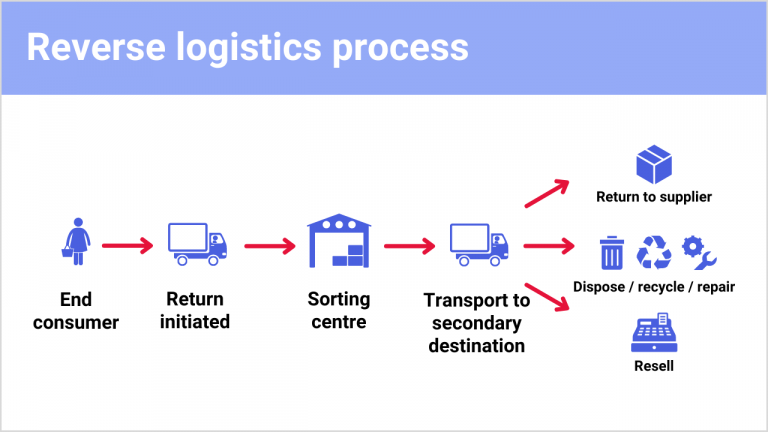What are reverse logistics and why do you need them?
Having a reverse logistics process in place can improve customer satisfaction and increase conversion rates.

Third-party logistics service providers have become an integral part of many businesses. They handle the in-betweens of your supply chain process, along with your last-mile deliveries. This helps you to save time and costs while allowing you to focus on other aspects of your business. Not all of them offer a reverse logistic system, however.
With online shopping becoming increasingly popular, and therefore competitive, any opportunity to stand out will provide an advantage. When consumers are researching a company, what often sets one brand apart from another are the reviews, which are closely related to customer satisfaction and ease of transaction.
In the digital age, it’s easier than ever to search for a brand or product and return dozens, if not hundreds of reviews. They can appear on websites such as Product Review and Trustpilot, on Google Reviews, and the company’s own social media pages and blog posts. And, quite often, negative reviews stem from shipping delays, a poor quality product or lacklustre customer service.
This is where reverse logistics can come in.
What are reverse logistics?
In basic terms, reverse logistics refers to the ‘reversing’ of any portion of the logistics process. Imagine that a retailer makes an order from a factory in China to their central warehouse in the USA.
These products then need to be delivered to bricks-and-mortar stores, which may fulfil online orders to consumers. They may also be shipped directly from the warehouse to the customer. Any returns back up the chain are covered by the term reverse logistics.

Most reverse logistics scenarios relate to the final transaction in this chain, with examples including post-sale refunds or warranty periods. The recall of defective products is also included here, as is the collection of products at the end of their life cycle for recycling or proper disposal.
Beneath an effective reverse logistics transaction is a complicated maze of fulfilment partners and processes, especially if you run an international business. Who pays the return postage to get the product back through the supply chain network, especially from a different country? (Hint: If it’s you, customers will react more favourably as it builds trust, and it will give you an edge over the competition.)
While you need to ensure the process is easy for the consumer, you should also consider your strategy for returned items. If a customer returns a damaged piece of clothing for example, or something in the wrong size, where does it end up? Will it be repaired, destroyed or placed back in your inventory?
The reverse logistics process can run from the end consumer all the way back to the point of origin.
What are the advantages of reverse logistics?
According to a survey of almost 7,688 consumers in the USA, free returns are an important consideration when purchasing online, rating highly with 76% of respondents. Easy returns, too, reduce the barrier to purchase and increase customer retention. They provide an advantage over other online sellers who have a lengthy or difficult returns process.
An easy returns process builds trust, since it shows that the company backs its product, and it provides a positive after-sale experience. Therefore, a well-planned reverse logistics strategy may enhance a company’s reputation, allowing it to differentiate itself from its competitors.
How can I improve my reverse logistics?
Firstly, to improve your reverse logistics, put a strategy in place for returned products. You can calculate whether it’s more cost-effective to dispose of damaged items, return to the supplier or sell as-is at a discount. The cost of returns and the hit to your bottom line should factor into your plan.
Next, create a sorting area and deal with shipments as soon as they arrive back at the warehouse. This will allow you to restock items quickly if you’re placing them back in your inventory, and keep your workspace uncluttered.
Finally, work with a logistics service provider that allows for returns. Sendle, for example, offers a hassle-free process for customers to return goods to the seller, as does DHL. For bonus points, ship your items in packaging that can be reused by the customer, should they want to return their purchases.
Disclaimer: These comments are the views and opinions of the author and should not be construed as advice. You should act using your own information and judgement. Whilst information has been obtained from and is based upon multiple sources the author believes to be reliable, we do not guarantee its accuracy and it may be incomplete or condensed. All opinions and estimates constitute the author’s own judgement as of the date of the briefing and are subject to change without notice. Please consider FX derivatives are high risk, provide volatile returns and do not guarantee profits.


Temu dropshipping: Pros, cons and alternatives
Temu offers a low-cost alternative to Amazon, but is Temu dropshipping a viable option? Discover more in this guide.
Dec / 2024
How to find dropshipping suppliers for your e-commerce business
Finding dropshipping suppliers can be very challenging. Take a look at all the places where you can find dropshipping suppliers
Dec / 2024
How to ship to Amazon FBA from China
Shipping goods from China to Amazon FBA comes with its own set of challenges. Discover how to get your goods from China to Amazon fulfilment centres.
Dec / 2024Choose a category below for more business, finance and foreign exchange support from WorldFirst.
- Almost 1,000,000 businesses have sent USD$150B around the world with WorldFirst and its partner brands since 2004
- Your money is safeguarded with leading financial institutions







































































